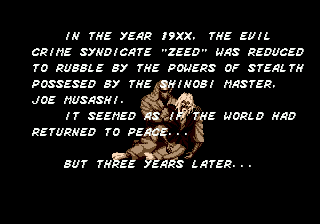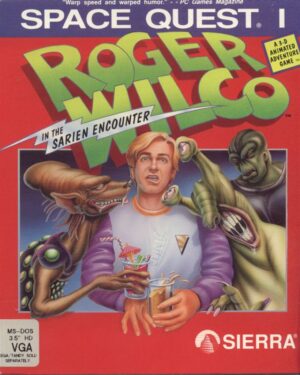Retro Replay Review
Gameplay
The Revenge of Shinobi brings back Joe Musashi with a potent mix of ninja agility and precise platforming. You’ll return to slashing through hordes of Neo Zeed bandits using kunai-throwing mechanics that feel tight and responsive. Each throw of the kunai or sweep of your katana sword demonstrates how well the controls have been tuned for fast-paced action. From the opening stages to the late-game boss encounters, the challenge remains consistently engaging.
(HEY YOU!! We hope you enjoy! We try not to run ads. So basically, this is a very expensive hobby running this site. Please consider joining us for updates, forums, and more. Network w/ us to make some cash or friends while retro gaming, and you can win some free retro games for posting. Okay, carry on 👍)
Along the way, you’ll break open boxes to uncover power-ups that convert your basic knives into fiery projectiles and grant you a razor-sharp sword. These power packs become essential for cutting through tougher enemy types, though you’ll need to watch out for booby-trapped crates armed with bombs. Health refills and extra kunai count also drop from destructible containers, rewarding exploration and risk-taking in every stage.
The game’s structure of eight distinct zones, each with three levels and a climactic boss fight, provides a clear sense of progression. You’ll traverse diverse environments—from rural forests and modern factories to highway rooftops and harbor strongholds—each introducing new enemy variants and platforming challenges. The steady ramp-up in difficulty and the variety of weapons wielded by foes keep every playthrough feeling fresh and demanding.
Graphics
As a late-era 16-bit title, The Revenge of Shinobi excels in sprite detail and colorful backgrounds that showcase Sega’s hardware capabilities. Character models are crisp and full of personality, with Joe Musashi’s animation frames lending real weight to every jump, slash, and throw. Enemies, too, are well-animated, whether they’re WW2-style soldiers or nimble ninja assassins launching shuriken.
Each zone presents its own visual theme, and the art team clearly paid attention to background layering and parallax scrolling. The rural town and forest areas exude traditional Japanese charm, while the urban landscapes feel appropriately gritty, complete with neon signs and factory smokestacks. Even the highway stage, with its Frogger-like traffic hazards, features smooth animation as cars whiz past and roadside objects blur in motion.
One of the more curious graphical touches lies in the licensed bosses you’ll encounter. Early releases featured likenesses of Godzilla, Batman, Terminator, and Spider-Man, leading to impromptu cameo battles that felt straight out of fan fiction. Later editions replaced these characters with more generic palette-swapped foes, but the overall boss sprite work remains imaginative and imposing, each giant opponent standing out against the stage backdrop.
Story
The Revenge of Shinobi picks up after the original Shinobi, thrusting Joe Musashi into a personal vendetta against the newly reformed Neo Zeed. Rather than freeing random hostages, your mission centers on avenging your slain master and rescuing your kidnapped bride. This simplified revenge plot gives you a direct emotional stake in each confrontation, transforming every enemy drop into a step closer to personal redemption.
While narrative exposition is minimal, it’s delivered with just enough flair between levels to maintain motivation. Short cutscenes and title cards set up each zone’s context—whether you’re pursuing kidnappers through a bustling city or penetrating a fortified island stronghold. The straightforward storytelling mirrors the gameplay’s relentless forward momentum, ensuring there’s never a dull moment spent in exposition.
The use of high-profile guest bosses in the early versions adds an almost tongue-in-cheek layer to the story, as if the Neo Zeed had enlisted the galaxy’s greatest anti-heroes to do their bidding. Even when those characters were swapped out for original designs, the sense of surprise and cinematic scale remained intact. All told, the plot serves its role well: it’s a driven, action-packed backdrop for one of the most iconic ninja romp adventures on 16-bit hardware.
Overall Experience
The Revenge of Shinobi stands as a quintessential action-platformer that balances tight controls, varied level design, and an unforgettable revenge narrative. Its difficulty curve remains challenging but fair, demanding both precision and strategic use of power-ups. You’ll find yourself replaying stages to master enemy patterns and perfect your timing on jumps, slashes, and knife throws.
Visually and sonically, the game nails the atmosphere of a high-stakes ninja saga. The blend of classic Japanese motifs with modern urban settings keeps each zone visually interesting, while the chiptune soundtrack drives the pace forward with energetic melodies. Boss encounters, especially the original licensed characters, leave a lasting impression and add to the title’s replay value.
Whether you’re a longtime fan of the Shinobi series or a newcomer seeking an old-school challenge, The Revenge of Shinobi delivers a cohesive and thrilling experience. Its blend of story-driven motivation, crisp 16-bit graphics, and relentless gameplay action makes it a must-own for Sega Genesis enthusiasts and platforming aficionados alike. Don’t miss your chance to embrace the path of vengeance as the legendary ninja Joe Musashi.
 Retro Replay Retro Replay gaming reviews, news, emulation, geek stuff and more!
Retro Replay Retro Replay gaming reviews, news, emulation, geek stuff and more!









Reviews
There are no reviews yet.